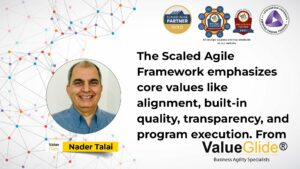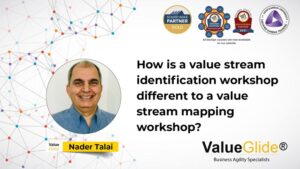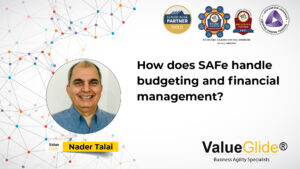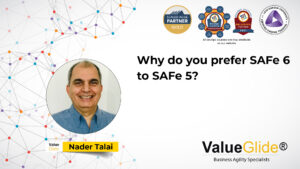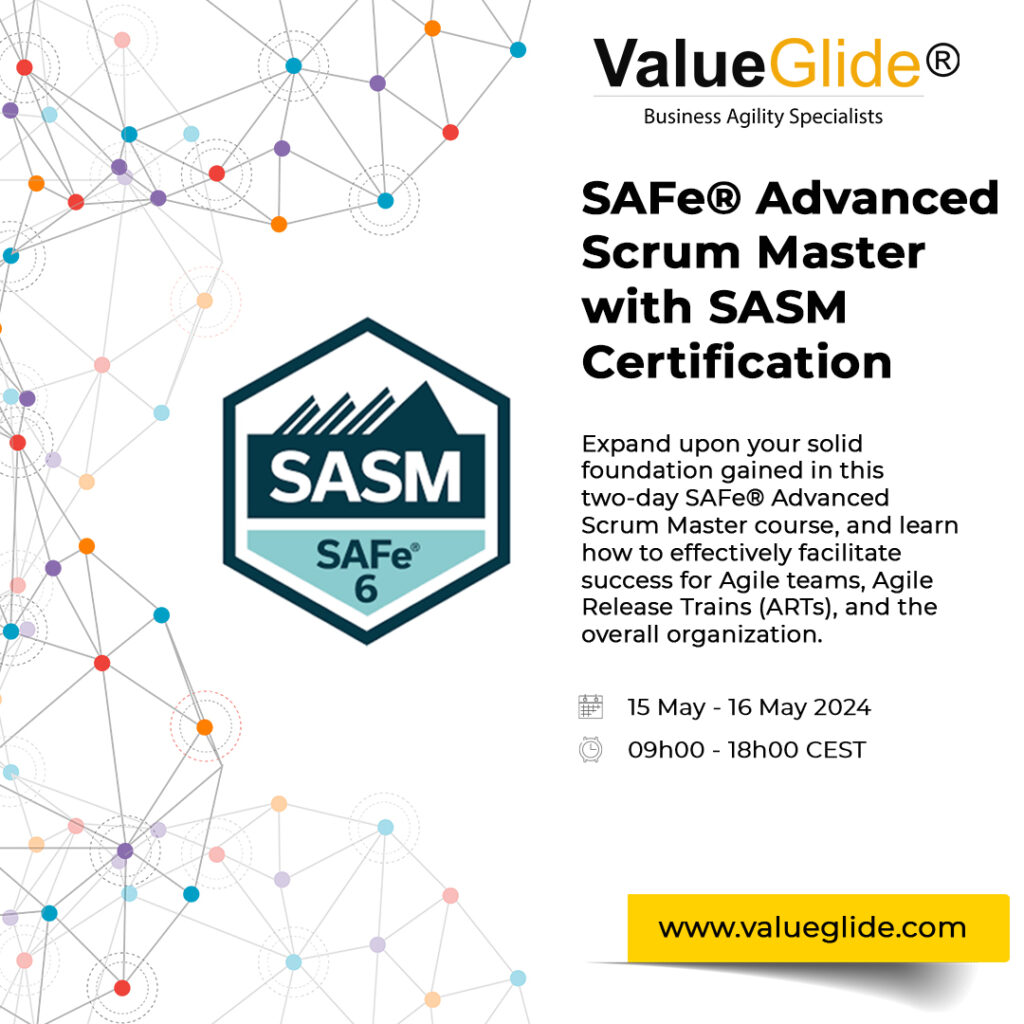
“Try, fail, learn” – Sir James Dyson
Fail well, avail of opportunities for learning. It’s a bit scary being so transparent, but hopefully rewarding in the long term.
Value Glide sees “growing agility” as a combination of art and science. Nader Talai is more of a scientist. John Coleman is more of an artisan. Science can be found in some of the component frameworks. Sometimes we just added principles from great experience reports like Extreme Ownership (Willink, 2015). The art is in how we assess integration of frameworks, how we integrate them for your context. We have plenty of case studies but we figure that an independent annual survey will tell its own story. Value Glide plans insofar as it can to run an independent annual survey with at least one (hopefully more than one) large agility organization and plans to conduct randomized controlled trials to attempt to falsify ideas in order to protect truth.
There are no sacred ideas, not even the words “I am the Change” from Value Glide. Why? To ensure growing agility artisans zone in on agility change like metaphorical guided missiles. We are inspired by the book “Black Box Thinking”, by Matthew Syed. It would be ironic if “Everyone else is the change” ends up being the truth as told by the data.
“You must be the change you wish to see in the world” – Mahatma Gandhi
I am the Change in three words is “resonating with people”, not necessarily via empathy, perhaps instead with rational compassion (Bloom, 2017).
I am the Change Agility change chefs resonate with people in relation to growth of good sustainable agility, whether those people are leading a change, subject to a change, or involved somehow. It’s a tried & tested context dependent meta-framework that integrates latest thinking from the top thought leaders in agility and change. It’s implemented in the lightest possible way in each context, and adapts as the latest feedback arrives.
{{cta(‘b23f06b4-325d-45cb-b289-f1cb7e754c45’)}}
The three value propositions are:
- I – I am the Change. I own the change. I am the role model for behaviours and thinking. Equally, what’s in it for me?
- V – create Viral networks/clubs of internal capability and change rhythm. The change is the work
- Y – whY? For what purpose? What outcomes do we expect? How will we measure?
Agendas:
- · Growth of sustainable purposeful agility – a focus on better leads to cheaper
- · The change is the work – no more transformation initiatives – be on the top of your game
- · It’s about collaboration and leading each other – transitioning the functional silo measures into system wide measures
- · Early delivery of value, early management of risk – continuously upping the bar on what “early” means
- · Products, transition from projects to long term stable teams, with appropriate finance model

I am the Change is about developing agility change chefs who grow good agility in a fit for purpose manner. Extending the metaphor….. Commis chefs will be on top on their own metaphorical station whether that is Cynefin (Snowden and Boone, 2007), Systems Thinking or whatever. Sous chefs will have a breadth across the techniques, while head chefs and executive chefs will have more mastery.
Growing good agility usually requires organization wide process/organization-design/mind-set/behaviour changes. Scaling of agility should be avoided. Small teams of your best people reduce complexity. If you must scale, it’s important to use something that is fit for purpose for your context.
I am the Change for agility transformability is a sophisticated meta-framework integrating thinking from the world’s best thought leaders in change and agility in a minimalistic fashion. It is a framework of frameworks and pieces of frameworks that dovetail together. The component frameworks and sub-framework components knit together differently depending on the context. To that end, we call it an integrative approach as opposed to an integrated approach. Here we attempt to outline the typical pattern, while understanding that not all ingredients are needed in every context, and additional ingredients are need in special contexts, such as check-lists. I am the Change is a first; comparing it to component frameworks would be a thinking mistake. It is important to recognise that because this meta-framework looks very different in different contexts, even within the same organization in the same location. It does not have a lot in common with cookie-cutter approaches.
“I dream things that never were; and I say, ‘Why not?’ ” – George Bernard Shaw
I am the Change approach for agility transformability has been tried and tested in the most difficult environments (banking, insurance); in fact that is what it’s designed for, difficult environments. It is adapted regularly, sometimes adding ingredients, sometimes taking some away. You need skilled chefs to apply it properly. Here is a metaphor for the meta-framework. Everything on the side-doors & running board of the car is optional, but maybe needed for some contexts.

We have sample patterns but no recipes. Over-simplification can be dangerous.
“Everything should be made as simple as possible, but no simpler” – Albert Einstein
We’re aiming to significantly improve the odds of success for your transformation. We’re also trying to ensure this will be your organization’s last agility transformation as we make change and continuous improvement part of the normal daily work, Continuous Transformation.
It is our experience that misunderstanding the complexity of thinking at your organization can lead blocked communications channels and we look to psychological techniques and professional coaching to help us with that.
Here is just one pattern……
I & whY
- Partner with leaders at the very top as peers. Be joined at the hip. Prepare an exit strategy for you and for people who end up in a “not for turning” state. Protect change agents to the extent that a NoNo (inspired by Leading Change – Kotter, 1996) strategy of simply holding out won’t work because they’ll be gone first.
- To that end, tap into the politics that is motivating the leaders/managers at all levels. Ok, let’s say we can start….
- Start with the why.
- Understand the “what” that leaders are agreeing to really; consider Viral Change® (Herrero, 2008) for teasing this out.
- We’re building transformability for agility, avoiding reliance on future change initiatives. Clarify and re-clarify the engagement style (partner/coach/mentor/teacher/doer). Aim for partner.
- Ask key influencers, formal and informal, for help. Ensure key influencers “believe the why” (Extreme Ownership [Willink, 2015]).
- Together, understand the current situation without doing a metaphorical archaeological dig. Drawing causal loop diagrams, Systems Thinking Approach to Implementing Kanban or STATIK (Kanban from the Inside – Burrows and Hohmann, 2014), Value Stream Mapping, and AgendaShift (Agendashift.com, 2017) are good approaches, Agendashift being the most complete.
- Apply Systems Thinking and in particular fundamental problem focus. Try the beer game from the Fifth Discipline (Senge, 1990) if people don’t understand that.
- Together, with fresh thinking understand the options available. This includes selection of methods, techniques, patterns or none for synchronisation of work for the maturity of the organization or the “smell of the place” (The smell of the place Sumantra Ghoshal at world economic forum, 2013). Try to start with DevOps over process, products over projects, recurring Discovery over Big Design Up Front (BDUF), Transformation Maps (T-Maps) over Gantt charts, Lean Finance over traditional cost accounting, fit for purpose tools over sunk cost fallacy.
- Be careful with off-piste, not every organization is like Spotify. If you’re in a Spotify like situation, you probably don’t need this approach anyhow. That said, don’t be afraid to be a chef if you know your ingredients well. For example, adding the Disciplined Agile (Disciplinedagiledelivery.wildapricot.org, 2017) architecture owner role to reduce architecture “anti-bodies” or using Nexus for synchronising components team work in a Scrum (Scrumguides.org, 2017) / Kanban (Anderson, 2010) / Discovery Kanban (Steyaert, n.d.) / The Lean Startup (Ries, 2011) (LSU) setting, or LeSS (Less.works, 2017) with a Nexus (Scrum.org, 2017) style retrospective.
- Communicate the I am the Change deal-breakers, not all of them immediate, and the consequences. One of the deal-breakers is always telling the truth. Agree repair interventions to remove immediate deal-breakers. Only do (what you think is) the wrong thing for a number of weeks while influencers discover why it’s wrong or you discover you’re wrong. If deal breakers ever get broken for longer, you have more deserving organizations – avoid being a victim.
- Together, surface shared assumptions, especially unwritten ones.
- In a recurring manner, diagnose the maturity of the people scope. Aim for behavioural change, change evolution, change leadership, Extreme Ownership (Willink, 2015), and/or Tipping Point Leadership (from the Hard Side of Change [Gladwell, 2005]) combined if appropriate for level of maturity. Consider Viral Change® (Herrero, 2008) with a licensed provider. Consider Theory of Constraints Reality Trees (Cox and Goldratt, 2008).
- Influence personal objectives, while they still exist. Surface unwritten assumptions at the top, and at every level (Schein, 2010). Discover likely behaviours should cost-cutting later transpire.
Viral networks/clubs & helping where there is strong “pull”
- It’s probably a multi-year journey. Together, establish a credible but still stretch 6-12 month challenge (every 6-12 months for possibly different people as the focus changes) for real change, going for measures of real change over metrics, as few as possible. Use the DICE calculator from the Boston Consulting Group (dice.bcg.com, 2017). With >70% failure in the change world, why start on a bad footing? Creative tension is fine. We just need to strike a balance.
- We aim for early & often story-telling.
- Prioritise areas that are “pulling”. You can generate pull from small successes. Be patient, don’t run in if there is no pull. Dare we say it, de-prioritise areas not pulling even if they are strategically more significant.
- Pressure test all existing plans and forecasts with Monte Carlo (Magennis, 2017) forecasting monthly, also watching out for the Black Swan effect (Taleb, 2011).
- Benchmark measures so improvement/dis-improvement can be tracked.
- Agree a regular cadence for re-forecasting, doing, reviewing, and learning. Include positive peer pressure from Tipping point leadership, avoiding “fire drills”. Progress action against I am the Change deal-breakers and I am the Change anti-patterns. Include communities of practice in the cadence so they’re treated seriously and have a rhythm in tandem with the 2nd violin. For every potential probe/baby step towards the challenge, test if we think it could make “the boat go faster/to-the-customer/to-paradise”, bearing in mind the Black Swan Farming affect (Yüce and Arnold, n.d.)
- Use Kanban (Anderson, 2010) /Scrum (Scrumguides.org, 2017) while a transformation team of key influencers exists.
- I am the Change only encourages experimentation in safe to fail environments; if you’re in that nice situation there are many options including Discovery Kanban (Steyaert, n.d.) / The-Lean-Startup (Ries, 2011) / Flawless-Execution (Afterburner, 2017) /Lean-Change-Management (Leanchange.org, 2017) / Lean-Enterprise (Barry O’Reilly, 2017).
- Use Toyota Improvement Kata (Rother, 2009) , baking it into the cadence so the change is the work, e.g., Sprint Planning, Daily Scrum, Sprint Review, Retrospective if using Scrum. Consider Popcorn Flow as an alternative. Also, bake in story-telling.
- Nurture champions, help them in any way you can. Protect them (cover and move – Extreme Ownership [Willink, 2015]). If you can use all of Extreme Ownership (Willink, 2015), please do that; if you have to dress it in the company values to reduce “anti-bodies”, please do that.
- Understand the short-term-ness of appetite for external help, and the need for the change to come from within. Develop permanent internal capability and ownership; include psychological skills. Upskill permanent staff on I am the Change for agility transformability and the appropriate components frameworks/sub-framework-components.
- Use Systems Thinking to resolve any lack of perceived benefit to collaboration from each individual’s perspective. Test if the system is rebalancing in an unspoken way to needing clear individual accountabilities & responsibilities and therefore dis-incentivising collaboration by individuals in reality (Morieux, 2017)
- Change the system. Systems drive behaviours.
- Build trust. Coach each other with permission. Never breach a confidence. Deliver on your promises. Be nice. Be happy. Be fun. Follow the values you ascribe to. Be a servant leader. Be a partner, sometimes mentoring, usually coaching.
- The only real buzz is pull and real change stories/data, everything else is superficial. Avoid distraction from superficial change & comms activities but try to use the change & comms machine to spread your stories.
- You are never finished. Declaring victory with change is naïve; the system is always waiting to re-balance.
- There is always room for improvement; make that improvement continuous via Toyota Kata.
- Always stakeholder mark; understand stakeholder perspectives and political noise while being careful to stay with Systems Thinking. Spread stories but most of all listen.
- If it’s not working, go back to the first step. If it’s definitely working, test if you really understand all of the fundamental problems.
- If someone is 80% there, support them.
whY & generating more “pull”
- “Walk the gemba” regularly, inspecting the work and the process rather than the people.
- Generate positive peer pressure through formalized informality while avoiding “fire drills”
- As you inspect & adapt on the current J-curve (Clapham, 2014), get ready for the next J-curve (Clapham, 2014) by concurrently going back to the first step, probably with a new transformation team as you focus on something different like for example Lean Finance or transition/deprecation of non-agility roles.
- Avoid internal competition – it leads to complacency; the competition is on the outside
- Be careful with 100% incremental change. We might be on the wrong track completely.
Contra-indications
- If you’re told publicly top leaders are behind you, the hatchet is coming. When things are good, are they ever that 100% confident in you really? So you think in the bad times it’s better? Just check out the English premier league or politics in most countries.
- Beware organizations that are commercially geared from the top to over-burden the knowledge workers (e.g., low price, followed by change requests – the road to perdition for lead times and under the hood quality). If you can’t avoid, consider the level of maturity, and to that end lower expectations.
- Avoid soft metrics if the organization is not aiming for true servant-leadership/stewardship/backstage-leadership. Refer to David Spann’s Agile Manager Behaviours. Company values on the wall are a dead give-away; they wouldn’t need to be said if they were really true, and people are unlikely to admit that they’re untrue.
- Avoid superficial change, even if it’s all you can show progress with.
- Avoid sheep-dipping people in ill-timed training, just because we have target to train X number of people. For those who don’t get it, try the “beer game”.
- Avoid best practice for unordered problems.
- Avoid being apolitical, even if you’re a contractor/consultant – it’s naïve and preachy. You don’t have to play political games, we’re not saying that.
- Avoid copy & paste.
- Avoid losing change agents who might be your best hope.
- Avoid dying in a ditch for something that doesn’t really matter in the bigger scheme of things.
- Avoid provocation of negative emotional reactions, aka “anti-bodies”.
- Avoid “pills” of potentially ill-fitting organization standards; get support or what you think is right. To avoid “anti-bodies”, build interfaces so what you’re doing appears the same.
- Avoid “who is the most Agile of them all” conversations. Agility thought leaders disagree with each other a lot. Indeed change leaders are no different.
- Avoid “that’s not Agile” conversations. It’s about outcomes. You might be part of the problem if you’re preaching.
- Look after yourself, your family, your friends, and your co-workers.
- Send us your stories and if you can some anonymous data.
- If you can’t do any of I am the Change, draw an invisible “mind your own business” box and within it, use Toyota Kata. Eventually, maybe you’ll get pull and real top-down support.
- Be careful with silver bullets; there aren’t any, I am the Change included.
- There can be delayed effects from interventions. The cure might be worse than the disease. If you’re getting glory, be prepared for the next fundamental problem.
Always be on the look-out for fundamental problems and dealing with them in a pattern-seeking way. Even if the change sustains for 7 years, beware of system rebalancing. As philosophers say, “let’s see”. Change sucks but we’re here to help you.
Hopefully, you can see now why we need agility change chefs. More detail is to come…
Frequently Asked Questions
Why do military techniques such as Extreme Ownership (Willink, 2015), Turn the Ship Around (Marquet, 2013), and Flawless Execution (Afterburner, 2017) feature strongly in is I am the Change?
It is to do with agility in regulated/controlled environments. The US Navy Seals, US Marines, and US Air Force managed to be agile in response to fluid organizations. We figure banks, insurance firms, oil companies and aviation need regulation and agility so we said to ourselves “why not borrow some tried & tested ideas?”. We’re just lucky that these ideas were published. If people from other countries had published similar work we’d be all over that too. It’s about ideas and how tested they are, not where the ideas come from.
How is I am the Change different from Lean Enterprise (Barry O’Reilly, 2017) and Lean Change Management (Leanchange.org, 2017)?
I am the Change often recommends Lean Enterprise (Barry O’Reilly, 2017) or Lean Change Management(Leanchange.org, 2017) as component framework/pattern options in safe-to-fail environments.
How is I am the Change different from AgendaShift (Agendashift.com, 2017) ?
Agendashift (Agendashift.com, 2017) is a potential component framework option for workshopping of recurring ideation & shaping of the change & possibly giving a rhythm to the change.
How is I am the Change different from behavioural change approaches such as Viral Change® (Herrero, 2008) ?
Viral Change® (Herrero, 2008) is a potential component framework option for figuring out the real change, generating pull, having backstage leadership, having formalised informal networks, and telling stories. People needing Viral Change® (Herrero, 2008) will need to use licensed providers or use alternative approaches recommended by I am the Change, such as its own principle sorting.
How is I am the Change different from Change Leadership (John Kotter, 1996)?
I am the Change recognises that all change must have support from the very top, but adds other component frameworks for keeping momentum and instead of aiming for quick wins, aims for quick story telling if Viral Change® (Herrero, 2008) is used for example. I am the Change combines push & pull with the larger emphasis on “pull”.
How is I am the Change different from change evolution approaches such as Kanban (Anderson, 2010) or Toyota Kata (Rother, 2009) ?
Sometimes revolution is needed, or at least more significant evolution (over steady continuous improvement). Indeed in most organizations, change leadership is also needed. Dare we say it, sometimes Tipping Point Leadership (Gladwell, 2015) is needed.
Why is Spiral Dynamics Integral (SDi) (Don and Beck, 2006; Beck and Cowan, 2014, Spiral Dynamics.com, 2017) a component framework option in the approach?
I am the Change had a similar pattern in 2012 to current day experiment oriented approaches. Other components have since been added to I am the Change other than SDi. We found that a key missing ingredient was using language that change participants can resonate with. SDi skilled partners tend to be able to ratchet their conversations up and down the spiral of thinking complexity, and thus have more effective conversations. I am the Change is focusing on the Dr. Don Beck version as opposed to Spiral Dynamics® (Spiraldynamics.org, 2017), mostly because we have a relationship with Dr. Don Beck, having been initially inspired by his audio book Spiral Dynamics Integral (Don, P. and Beck, D., 2006).
Why does I am the Change not use Frederic Laloux’s Reinventing Organizations (Laloux, 2015) ?
I am the Change does refer to Reinventing Organizations (Laloux, 2015). Some presentations directly refer to it, as a means of explaining which component frameworks might help at different stages of organizational culture maturity. Indeed Gareth Morgan’s (Morgan, 2006) culture metaphors were always part of the I am the Change approach. SDi provides a toolkit for having meaningful conversations rather than us wondering how we can make our organization teal. Many people in agility are getting excited by Teal. We get more excited about relating to the people in front of us, so we emphasise psychological approaches like SDi and professional coaching. Culture change is fraught with difficulty. What we can do is hack/nudge the culture of the organization slowly. If the culture changes quickly, that’s a bonus; although we would be suspicious, and we’d be on the lookout for a system re-balancing act to counteract the change. The change is never over, it’s part of the work.
How does this compare / contrast to Michael Sahota’s work?
Michael Sahota also talks about “growing agility”. I am the Change is a foundation for the development of agility transformability chefs and has a lot of overlap (why are you doing this, method fit etc.) but I am the Change also a lot of additional content.
Does I am the Change dilute any on the component frameworks?
No. It may sometimes supplement them though. There are times though when we don’t fully yet endorse the framework but we liked one of the ideas in certain cases. We’re clear when we do it. It’s rare.
Do the top agility thought leaders and change thought leaders support I am the Change?
That remains to be seen. We have invited thought leaders from agility & change to collaborate. Some thought leaders have been very generous with their time. Some are very supportive. Even some thought leaders who didn’t support it helped a lot with their critique of our thinking. Some other thought leaders communicated that nothing other than their own individual approaches were needed, and we understand because we also love their approaches – we just think we can get them to work together. Let’s see what the science says.
I am the Change – the change starts with me, the last mile is with me. Let I am the Change promote your agility transformation pawn to a queen or to any piece on the chess board you need, and you’ll need no other.

John Coleman, Nader Talai – London, UK
Value Glide
I am the Change for Growing Agility & Agility Transformability by John Coleman is licensed under a Creative Commons Attribution-NonCommercial-NoDerivatives 4.0 International License.
Based on a work at www.valueglide.com.
Permissions beyond the scope of this license may be available at www.valueglide.com.
References
Afterburner. (2017). Flawless Execution | Afterburner Inc. [online] Available at: https://www.afterburner.com/products-solutions/flawless-execution/ [Accessed 11 Mar. 2017].
Agendashift.com. (2017). Home | Agendashift. [online] Available at: https://www.agendashift.com/ [Accessed 11 Mar. 2017].
Anderson, D. (2010). Kanban: Successful evolutionary change in your software business. United States: Blue hole press.
Anon, (2005). The hard side of change management. [online] Available at: https://hbr.org/2005/10/the-hard-side-of-change-management [Accessed 19 Oct. 2016].
Anon, (n.d.). Leandro Herrero web site. [online] Available at: http://leandroherrero.com/ [Accessed 20 Oct. 2016].
Barry O’Reilly. (2017). Lean Enterprise. [online] Available at: https://barryoreilly.com/lean-enterprise/ [Accessed 11 Mar. 2017].
Beck, D. and Cowan, C. (2014). Spiral Dynamics. 1st ed. Somerset: Wiley.
Bloom, P. (2017). Against empathy. 1st ed. Random House / Ecco Press.
Brougham, G. (2015). The Cynefin Mini-Book. United States: Lulu.com.
Burrows, M. and Hohmann, L. (n.d.). Kanban from the inside. 1st ed.
Clapham, J. (2014). David Viney, who did some of the original research on the effect of perceived change, to use his J-Curve in Steve Fullmer’s courseware and related delivery.. [online] Available at: https://johnclapham.wordpress.com/tag/viney/ [Accessed 20 Oct. 2016].
Cox, J. and Goldratt, E. (2008). The goal: A process of ongoing improvement: 25th anniversary edition. 25th ed. United Kingdom: North River Press Publishing Corporation, The.
Dice.bcg.com. (2017). Dice: A tool for Executional Certainty. [online] Available at: http://dice.bcg.com/index.html#intro [Accessed 11 Mar. 2017].
Disciplinedagiledelivery.wildapricot.org. (2017). Disciplined Agile Consortium – Home. [online] Available at: https://disciplinedagiledelivery.wildapricot.org/ [Accessed 11 Mar. 2017].
Don, P. and Beck, D. (2006). Spiral dynamics integral: Sounds true audio learning course: Learn to master the Memetric codes of human behavior. United States: Sounds True.
Fulmer, S. (n.d.). J-Curve image (courtesy of Steve Fulmer). [online] Available at: http://blogs.interfacett.com/wp-content/uploads/2012/06/001-PMP-J-curve-Leading-Change.png [Accessed 19 Oct. 2016].
Fussell, C. and McChrystal, S. (2015). Team of Teams: The Power of Small Groups in a Fragmented World. Portfolio Hardcover.
Geary, C., Matts, C. and Maassen, O. (2016). Commitment: Novel about managing project risk. United States: Hathaway Te Brake Publications.
Ghandi, M. (n.d.). .
Gladwell, M. (2015). The tipping point. 1st ed. London: Abacus.
Group, T. (n.d.). Dice: A tool for Executional certainty. [online] Available at: http://dice.bcg.com/index.html#intro [Accessed 19 Oct. 2016].
Hatt, C. (2004). Mahatma Ghandhi. Milwaukee, WI: World Almanac Library.
Herrero, L. (2008). Viral Change. Chalfont Project T/A Meeting Minds Publishing.
Hickman, C., Smith, T. and Connors, R. (2011). The oz principle: Getting results through individual and organizational accountability. New York: Penguin Group (USA).
Johnson, S., Mueller, P., Rathgeber, H. and Kotter, J. (2006). Our iceberg is melting: [changing and succeeding under any conditions]. 17th ed. New York: St. Martin’s Press.
Juarrero, A. (2002). Dynamics in action: Intentional behavior as a complex system. Bradford Book.
Katz, B. and Brown, T. (2009). Change by design how design thinking can transform organizations and inspire innovation. New York, NY: HarperCollins Publishers.
Kotter, J. (1996). Leading change. Boston, MA: Harvard Business School Press.
Laloux, F. (2015). Reinventing organizations. 1st ed. Leuven: LannooCampus.
Leanchange.org. (2017). Lean Change Management | Lean Change Management. [online] Available at: http://leanchange.org/lean-change-management/ [Accessed 11 Mar. 2017].
Leankanban.com. (2017). Guide | Lean Kanban. [online] Available at: http://www.leankanban.com/guide [Accessed 11 Mar. 2017].
Less.works. (2017). Overview- Large Scale Scrum (LeSS). [online] Available at: http://less.works [Accessed 11 Mar. 2017].
Magennis, T. (2017). Focused Objective – Agile Forecasting, Portfolio and Risk Management Tools. [online] Focused Objective. Available at: http://www.focusedobjective.com [Accessed 11 Mar. 2017].
Marquet, D. (2013). Turn the Ship Around!: A True Story of Turning Followers into Leaders. Portfolio.
Morgan, G. (2006). Images of organization (updated edition). Thousand Oaks, CA: Sage Publications.
Morieux, Y. (2017). Yves Morieux: As work gets more complex, 6 rules to simplify. [online] YouTube. Available at: https://www.youtube.com/watch?v=0MD4Ymjyc2I&t=190s [Accessed 12 Mar. 2017].
Review, H., Press, H. and Kotter, J. (2011). HBR’s 10 must reads on change management (including featured article “leading change,” by john P. Kotter). Boston, MA: Harvard Business Review Press.
Ries, E. (2011). The lean startup: How today’s entrepreneurs use continuous innovation to create radically successful businesses. New York: Crown Publishing Group, Division of Random House.
Rother, M. (2009). Toyota kata: Managing people for improvement, adaptiveness, and superior results. New York: McGraw-Hill Companies, The.
Schein, E. (2010). Organizational culture and leadership. 4th ed. San Francisco, CA: Wiley, John & Sons.
Scrum.org. (2017). Scaling Scrum with Nexus™. [online] Available at: https://www.scrum.org/resources/scaling-scrum [Accessed 11 Mar. 2017].
Scrumguides.org. (2017). Home | Scrum Guides. [online] Available at: http://www.scrumguides.org/ [Accessed 11 Mar. 2017].
Senge, P. (1992). The fifth discipline: The art and practice of the learning organization. London: Business Books (Random Century Group).
Snowden, D. and Boone, M. (2007). A Leader’s Framework for Decision Making. [online] Harvard Business Review. Available at: https://hbr.org/2007/11/a-leaders-framework-for-decision-making [Accessed 11 Mar. 2017].
Spann, D. (2017). Agile Manager Behaviours. [online] Available at: http://programmedevelopment.com/public/uploads/files/agile_management_behaviours.pdf [Accessed 11 Mar. 2017].
Spiraldynamics.com. (2017). Spiral Dynamics Gateway. [online] Available at: http://www.spiraldynamics.com/ [Accessed 11 Mar. 2017].
Spiraldynamics.org. (2017). spiral dynamics ® | NVC Consulting – Spiral Dynamics® Training & Graves Theory. [online] Available at: http://spiraldynamics.org/ [Accessed 11 Mar. 2017].
Steyaert, P. (n.d.). Discovery Kanban (registered trademark of Okaloa). [online] Available at: http://www.discovery-kanban.com/ [Accessed 19 Oct. 2016].
Syed, M. (2016). Black box thinking. 1st ed. London: Portfolio Penguin.
Taleb, N. (2011). The black swan. 1st ed. London: Allen Lane.
The smell of the place Sumantra Ghoshal at world economic forum. (2013). YouTube.
Wilbur, K. and Wilber, K. (2000). A theory of everything: An integral vision for business, politics, science, and spirituality. Boston: Shambhala Publications.
Willink, J. (2015). Extreme Ownership How U.S. Navy Seals Lead & Win. St. Martin’s Press.
Yüce, Ö. and Arnold, J. (n.d.). Black Swan Farming. [online] Available at: http://blackswanfarming.com/cost-of-delay/ [Accessed 19 Oct. 2016].

